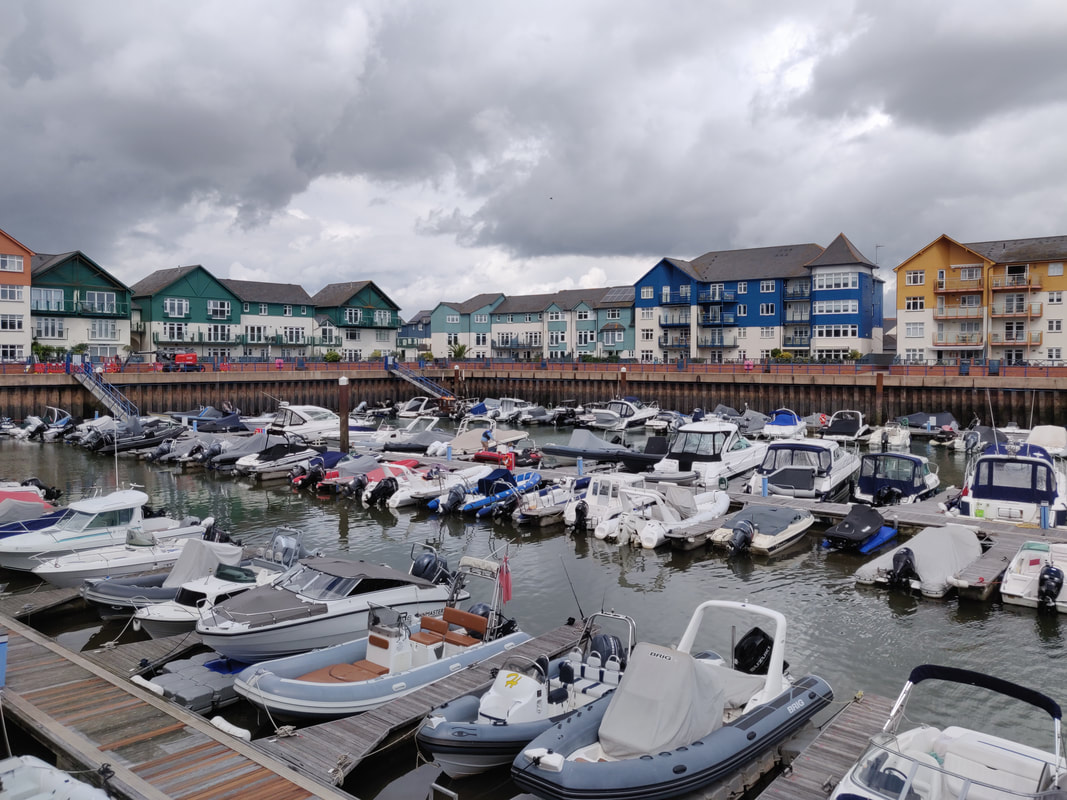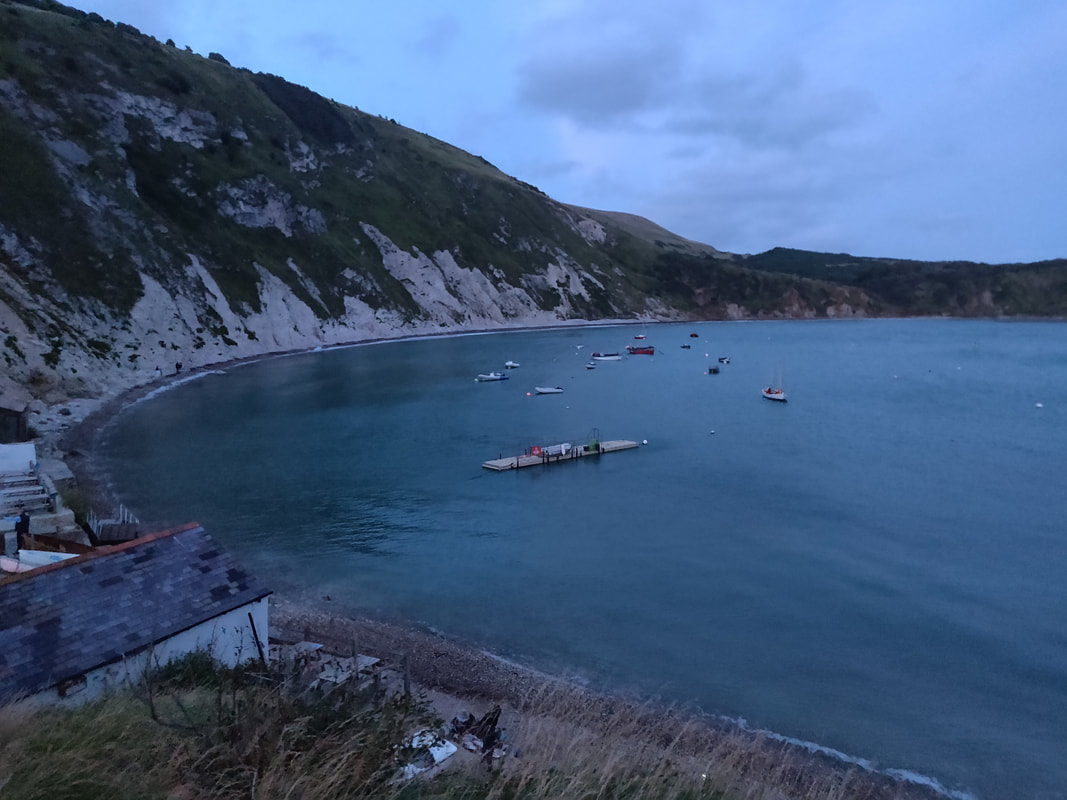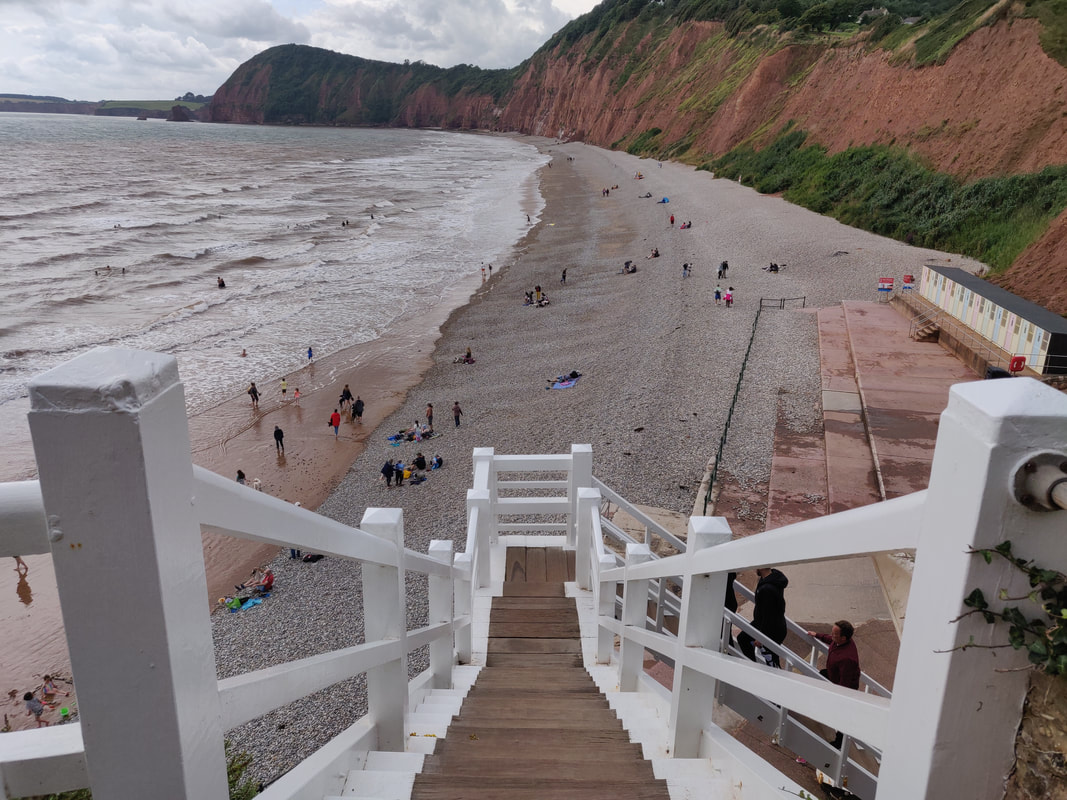SummaryAirport Rating n/a Reception of locals **** Cost: £££££
200 million years of historyThe Jurassic Coast - I don't know about you, but few places in the world have a cooler sounding name, and this 96 mile stretch of the English south coast has earned its name. The area we now know as coastal has, at various times of the past quarter of a billion years, been a desert, swampland, and even a tropical sea. Today, the tall cliffs of the coastline are continuously eroded away by the English Channel, plate tectonics and weather to uncover the layered history of the area - an area that has the fossilised remains of plants and animals dating back almost 200 million years. There are examples of life through some of the most famous time periods from the age of the dinosaurs, from the steep red cliffs dating back to the Triassic, to the clay and shale further east that dates to the Jurassic and Cretaceous. The whole area is a UNESCO World Heritage Site in recognition to its importance to the study of geology, with well preserved fossils found across the entire stretch of the Jurassic Coast. 96 miles is a lot of distance to cover, especially as you stop at various points of interest - but I wanted to see if I could do the distance in one day while having time to experience the unique sights and sounds of each stop. ExeterExeter isn't actually part of the Jurassic Coast, but a great city to use a base. The city itself is a nice place to visit, and I spent a couple of days walking through different areas to get a feel for the place. It's a city with a fairly high student population thanks to the large University of Exeter campus near the city centre. I walked through the university and the campus is fairly large. While it lacks the scale of some of the large universities, or unique landmarks like you might find in places like the University of Birmingham or Oxbridge, it's still a nice campus to take a walk through. Located near the mouth of the River Exe, Exeter has plenty of space near waterways, and the quay area is a particularly picturesque walk. It doesn't have quite the charm of some of canal walks in the Midlands, or the bustle of a river walk in London - but for someone from a landlocked part of the country, it's always nice to see larger bodies of water than the narrow canals we have. There are some bars and restaurants that dot the area and it was a good place to sit for a few hours after a long walk, if not a little quiet. It felt like it was an area that wasn't quite reaching its potential given the location but I'm sure during sunnier days the place is a lot busier. There were a few places that I wanted to visit that were unfortunately closed due to the pandemic. I was particularly disappointed to miss out walking through the Underground Passages, a series of subterranean tunnels that were used to transport water during the Middle Ages. Exeter is an old city, and there are examples of its ancient past throughout the city, but none more imposing or spectacular as Exeter Cathedral. Dating back to 1112, much of the present building was completed by the early 1400s. If you've read my blogs before, you'll have seen examples of cathedrals all over the world I've visited, and I'll be honest, this one is right up there with the very best. While many cathedrals are free to enter, for Exeter Cathedral it costs £5 to enter. It's a reasonable price to pay to help with the upkeep of a building that has a history dating back almost a millennia. While imposing on the outside, it is incredibly beautiful on the inside and contains the world's longest uninterrupted stone vaulted ceiling dating back to the Middle Ages. Despite sustaining damage throughout the centuries, from the English Civil War to German bombing attacks in the Second World War, most of the cathedral has remained intact which makes the ceiling all the more impressive. Standing at one end of the cathedral and looking up, the ceiling extends as far as building is and it's height, detailed decoration and scale make it one of the more extraordinary pieces of architecture I've seen. The other element of particular note is one of the oldest astronomical clocks in the world. If you read my article on Prague, you'll remember the astronomical clock there is a major tourist attraction, and while this might not be so big, it's no less interesting. Built in 1484, the clock shows the time, age of the moon and phases of the moon. It's one of many interesting features around the cathedral and I spent a good 30 minutes walking around. It's a cathedral that is still very much in use, so don't be surprised to find yourself walking around while a service is running (like I was). It's good to see buildings as beautiful and as old as these still being used for their designed purpose rather than just being museum pieces to look at. Exmouth to SidmouthExmouth is the western end of the Jurassic Coast and the perfect starting point for travelling between the key parts of the coast. The only problem was, I didn't reach Exmouth until late in the morning, meaning I had really restricted the time I could spend at each stop, Compared to some of the towns and villages I visited, this was one of the bigger ones - centred around Exmouth beach. The beach itself at low tide is large but was a little unclean when I took a walk through, Seaside towns in England tend to be home to an older demographic, and Exmouth is no different. The town centre, recently redeveloped, is small but functional, while a walk along the Beacon Terrace, a hill above the waterfront, was a good way look over the waterfront. The prettiest part of Exmouth is the marina area, home to multicoloured houses and flats overlooking both the waterfront, and a small marina moored with a lot of boats. It was a bit of a maze trying to find my way out of the marina with one block leading to another (I got lost even with Google Maps), but it felt very different to the rest of the town, with a younger demographic and brighter colours. I won't lie, I probably spent a little too long here, which impacted what I was able to see later in the day. There's certainly nicer places to stop off for longer periods of time during the route.. The next stop is Budleigh Salterton, and although it's a much smaller town, there's still plenty to see. The most spectacular part of this area is the tall red quartzite cliffs that tower over the waterfront like nature's skyscrapers. The beach here is almost all pebbles, many of them beautifully shaped and coloured, and they are locally protected and formed from coastal erosion acting on the cliffs. The beach area was almost completely empty, and the rocky landscape with tall red cliffs gave the area an otherworldly feel. Again, I probably spent a little more time than I had to here which had a knock-on effect for the rest of the day, but I'd definitely recommend stopping off at Budleigh Salterton for its unique landscape. The final part of the first leg is Sidmouth, a sizeable town with two beaches and a lot to see and do, it's also where I spent the longest time. Parking near the 15th century Tower of Sidmouth Church, the walk into town via the Jacob's Ladder beach is pretty special. The Tower dominates the skyline of the beach and provides a great view over the beach area looking into the town. Next to the Tower are the Connaught Gardens that date back to the 1820s and provide a beautifully landscaped area with flowering plants, manicured lawns and places to sit and rest. The gardens are connected to the beach by a landmark that gives the beach its name, the Jacob's Ladder. The ladder is a set of beautiful white steps built in a Victorian style construction, although they are relatively new. The ladder provides a stunning view of the other side of the beach away from the town and looking toward the large red cliffs dating back to the Triassic. The beach area here is busier than both Exmouth and Budleigh Salterton, and is a mixture of sand and pebble. The Jacob's Ladder beach splits into the Sidmouth Town beach as you head toward the town. The town here is much larger than Budleigh Salterton, while also being nicer than Exmouth. There's a lot of independent shops, and the relatively narrow streets make the town feel even more crowded than it is. Sidmouth to Lyme RegisHeading out of Sidmouth, it was already pretty late in the afternoon, and it became obvious that I wouldn't be able to see the whole of Jurassic Coast and so I began to pick and choose the places I wanted to see. Luckily, I managed to see most of this section. Beer is a 20 minute drive from Sidmouth and without question the most picturesque and beautiful village on the Jurassic Coast. Growing as a smugglers cove in the 18th century, the village then began generating income from fishing and quarrying - although the primary source of income now is tourism. The village buildings look like something from a postcard, and the coastal area, split between the cliffs above and the beach below, give excellent views across the cove. Fishing is still a sizeable industry at Beer, and fishing boats are laid out across the cove and beach area which strongly reminded me of Brittany and Ploumanac'h. Seaside areas of the UK aren't always the nicest but Beer is an exception and should definitely form a part of any journey along the Jurassic Coast. The next stop along the coast is the fishing town of Seaton, a much bigger settlement and only a short 5 minute drive from Beer. Despite the distance, the difference between the two settlements is pronounced. While Beer has a picture perfect charm, Seaton felt a lot more like those English seaside towns that seem neglected. I spent some time in the beach area, but this felt more like a functional town that happened to be on the coast, rather than a coastal town. It was back to an older demographic, and the whole place felt a little tired. From Seaton I followed the River Axe, slightly away from the coast into Axmouth. The port at Axmouth once accounted for 15% of the UK's shipping trade during the Middle Ages, but today it is a small fishing village filled with thatched cottages and old houses and churches. It was a good place to take a little break and to get some food (The Ship Inn was a great place to eat) before a 10 minute drive to Lyme Regis. Beyond Lyme RegisThis is where I knew I had messed up trying to do the Jurassic Coast in one day. It was already the evening as I entered Lyme Regis, the hills of the surrounding area giving way to a drop through the main town heading toward the coast. Lyme Regis manages to combine the two rare characteristics of UK seaside towns; it was both lively and beautiful. This is close to the geographical centre of the Jurassic Coast and it definitely felt like the real beating heart of the area. The town itself dates back at least a millennia, but fossils in the cliff here date back all the way back to the Jurassic as the cliffs transform from quartzite to clay and shale. Some of the earliest, and most important, dinosaur fossil finds happened in the area around Lyme Regis and even today fossils can be found in abundance. The town is aesthetically very beautiful, not quite as pretty as Beer, but given its size, perhaps the best town on the coast - and no surprise that its nickname is the Pearl of Dorset. The walk through the main town is gorgeous, as the steep hill provides beautiful vistas over the coastline. Lyme Regis has both sandy and rocky beaches and numerous museums that I wish I could have visited had I more time. The waterfront along the beach was very busy, with some of the standard attractions you get at beaches, interspersed with things you don't get to see everyday (like Morris dancers). I ended up making my way through the sandy beach to The Cobb, a harbour wall that is said to have been there in one form or another for almost a thousand years. The current wall dates back to the 19th century, previous walls being washed away by storms. It's a great place to stand near the water and to get a great view back toward the town and over the harbour. On the other side of The Cobb is a pebble beach where many of the fossils can be found. Despite having a short search, I couldn't find any fossils, but an annual fossil festival where people go around searching the beach usually returns large numbers of small fossils. If I could do the Jurassic Coast again (and I hope I do), this is where I would break up the journey and stay the night. I'd love to learn more about Mary Anning, the early fossil hunter who had a large influence on the study of archaeology. It's on the site of her former church that the current Dinosaurland Fossil Museum now exists. I'd love to spend more time on the waterfront, visiting the Town Mill and discovering the town itself, and in many ways I wish I had ended my journey here and saved the second section of the Jurassic Park for another visit. But I didn't, and that ended up being a mistake. In order to try and reach both Lulworth Cove, as well as Durdle Door (1 hour away) I decided to skip most of the entire next section - which meant missing out on Charmouth, Chesil Beach and Portland Harbour. Perhaps my biggest regret was missing out on the Golden Cap. This is the highest point on England's south coast and supposedly a really good hike. However, it became apparent as the sun began to set that Golden Cap would have to be saved for a return visit. Unfortunately, despite my best intentions, I also didn't manage to visit the famous Durdle Door, a 60 metre natural limestone arch. It's one of the must-see attractions of the Jurassic Coast, but I arrived in the area too close to closing time to make the journey viable (the car park also closed a little early). While it was a shame, it meant I could enjoy the evening a short drive down the coast in Lulworth Cove. The cove is beautiful, a narrow entrance opening up to a harbour and beach area, and as the evening turned to night, the gentle movement of the waves meant a very relaxing end to a frantic day of travelling. The cove receives up half a million visitors each year, but in the darkened night, there were just a handful of people around. While this meant I experienced a uniquely peaceful experience, as the hours went from the dusk of the late evening into the black of the night, I only had a short time to be able to see the surrounding landscape. Frustratingly, Durdle Door was a short walk away, but given the conditions and lack of light, I realised that I'd probably have to return to better experience the eastern portion of the Jurassic Coast. Would I recommend the Jurassic Coast?I set out to discover and experience the Jurassic Coast and find out if it was possible to visit the key landmarks in a day. At the end I realised, one day is simply not enough time - but it's a good place to visit - whether you're based in England or reading this from abroad. The Jurassic Coast is beautiful, and in various parts it doesn't feel like you're in England at all - but there are places that I perhaps would have spent less time in if I could do it again. I spent a morning in Exeter Cathedral, and starting in Exmouth would certainly have saved some time. I would have spent less time in Seaton and Exmouth and more time in places like Beer and Lulworth Cove. I definitely wouldn't recommend doing the entire coast in a day, and if I do this trip again, I'd like to stay the night near Lyme Regis and visit the various attractions in the town. It would then give me an entire day on the eastern part of the Jurassic Coast and I'd like to hike up Golden Cap, and experience places like Durdle Door, Chesil Beach and Portland Harbour. For those of you thinking about making the trip, do yourselves a favour and split your journey along the coast in two - or focus on one of the sections either east or west of Lyme Regis. If you're travelling on a budget, bring a packed lunch because some of the food can be overpriced, but I had no issues with parking or walking around as a Sikh. Given the area is a tourist hotspot I'm sure they get a handful of Sikhs each month, and although I didn't see any east of Exeter, I also didn't have any problems. Comments are closed.
|
AuthorBritish Sikh, born in the Midlands, based in London, travelling the world seeing new cultures. Categories
All
|








 RSS Feed
RSS Feed